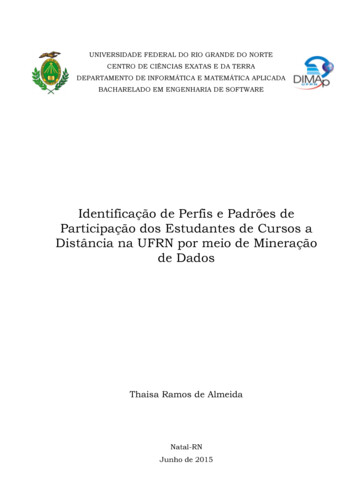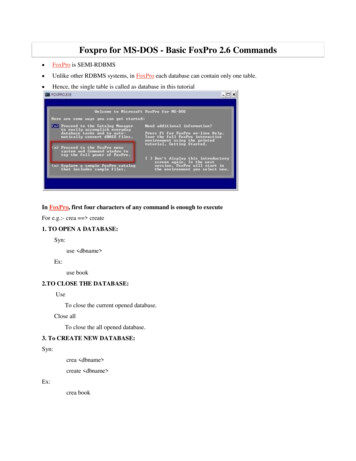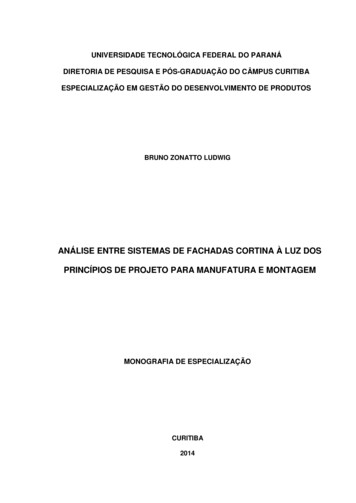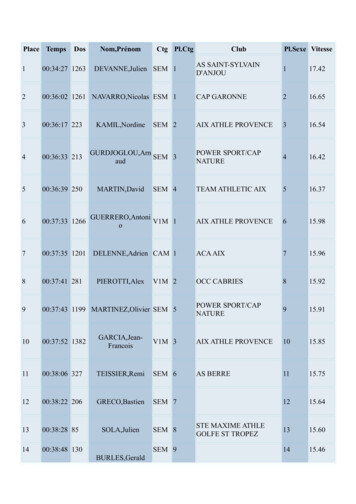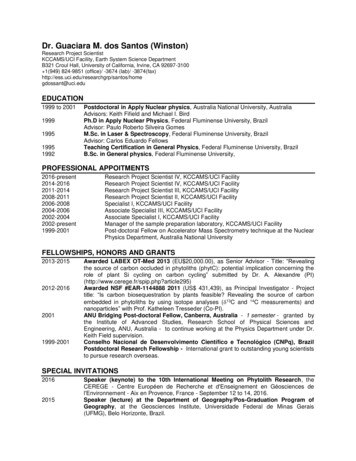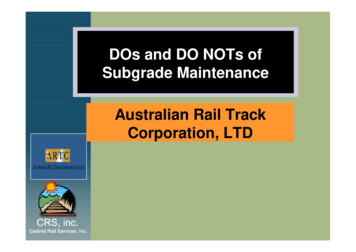
Transcription
DOs and DO NOTs ofSubgrade MaintenanceAustralian Rail TrackCorporation, LTD
Why are we here? ImproveSafety Improve quality of the track structure Reduce re-work Review examples of real life problems Exchange stories and experiences
Today’s Program1. Subgrade Maintenance2. Trench Drain Construction
Presentation Outline SoftTrack Ballast Pockets Drainage Culverts Construction Practices Over Steepened Slopes Riprap Record Keeping
Presentation Outline SoftTrack Ballast Pockets Drainage Culverts Construction Practices Over Steepened Slopes Riprap Record Keeping
Idealized Track SectionSleeperR ailT ieB allastS u b b allastS u b g rad e
Less Than Ideal Track SectionTHIN,CONTAMINATEDBALLAST LAYERNO TOPFORMATIONDEFORMEDCLAYSUBGRADE
Another Less than Ideal EDSUBGRADENO TOPFORMATION
What is “Soft Track”?
What is “Soft Track”?
What is “Soft Track”?
What is “Soft Track”?
What is “Soft Track”?
What is “Soft Track”? Ballastfailure and pumping track Top Formation failure Shallow subgrade failures Rigid layer “mud”pumping Embankment failure Landslides
Contributors to “Soft Track” WaterWeak Subgrade SoilOverstressed SoilFouled Ballast Poor InitialConstructionPoor MaintenancePracticesOver Loaded andOver SteepenedSlopes
Water is a Major Contributorto Soft Track and the key to reducing theoccurrence of soft track is DRAINAGEDRAINAGEDRAINAGE
Presentation Outline SoftTrack Ballast Pockets Drainage Culverts Construction Practices Over Steepened Slopes Riprap Record Keeping
The Ballast Pocket Water trapped in a ballast pocketis a major contributor to many softtrack situations Ballast Pocket
Ballast Pocket Exposed inTrench below TrackBALLASTPOCKETCLAY
Ballast Pockets under each RailHEAVEDCESSDEFORMEDSUBGRADEBALLASTPOCKET
Water Flowing from Ballast PocketBALLASTPOCKETWATER
Ballast Pockets associated withCommon Subgrade Failure ModesDirection ofGround MovementFailure SurfaceUndercutting does not removeor drain the ballast pocketBallast pocketdevelopment.Water trapped indepressions under rail.Bearing failure (withshear displacement).Water saturated ze,minimal minimalsubgradesubgradedeformation.deformation.
Ballast Pockets associated withCommon Subgrade Failure ModesSeepsShallow shearfailure blocksditch.Failure SurfaceSeepsDeepershearfailure.Failure Surface
Presentation Outline SoftTrack Ballast Pockets Drainage Culverts Over Steepened Slopes Construction Practices Riprap Record Keeping
Sources of Water Rainor snow Surface water infiltration Water within the track structure Groundwater
Proper Surface Drainage is probably the least expensive andmost easily implemented measure forpreventing soft track problems orimproving performance of soft trackareas
Indicators of Poor Drainage
Wet Ground near or on theEmbankment
Ponded Water Adjacent to Track
Cattails on Slope above Track
Water Ponded in Ditch andWetlands Plants
Infiltration and Embankment FailureResulting from Poor DrainagePonded WaterCracksTrackPonded illInfiltrationFailure Surface
Cess Failure due in part to PoorSurface DrainageBERM ALONGCESSPONDED WATERCONTRIBUTEDTO FAILURE
Improved Surface DrainageCleanditch,cessprovidedrain, provideCleanadequateadequateslope so slope ch,or cleanadd or addculverts,etc.etc.culverts,Slope shouldercess to drain.Slopeto drain.TrackDo notnotconcentrateconcentrateDoflows.flows.Fill
Surface DrainageDos and Do Not’s DOdivert water away from track DO keep cess drains clean andgraded DO keep cesses clean and sloped todrain DO NOT let water pond DO NOT let water infiltrate theembankment
Subsurface DrainageSystems are effective for draining water from soil draining water from ballast pockets draining water from cracks in theground lowering the groundwater elevation intercepting water flowing toward thetrack
Examples of SubsurfaceDrainage Systems Drainsoriented perpendicular to thetrack Drains oriented parallel to the track Drains in wet areas further awayfrom the track
Trench Drains Perpendicular to Track are discussed in the second half of the course
Shallow Trench Drains InstalledParallel to the TrackLoweredGroundwaterTableTrench drains, depth varies,3-feetminimum.minimum.1 meter
Deep Trench Drain Parallel to TrackWater-loving Plants orSprings on Slope FaceFillGroundwater Elevationin Fill Before InstallingTrench DrainLowered 515-Ft.MetersDeepTrench DrainTrenchDrain(typical)(typical)
Subsurface DrainageDos and Do Nots DOdrain ballast pockets DO construct cutoff drains upgradeof soft track DO NOT construct deep drainswithout the assistance ofexperienced personnel DO NOT get in trenches
Presentation Outline SoftTrack Ballast Pockets Drainage Culverts Over Steepened Slopes Construction Practices Riprap Record Keeping
Culverts are part of the surface drainagesystem
Common Culvert Problems Noculvert installed Culvert too small Spacing between culverts too great Culvert plugged Culvert damaged Drainage toward inlet not properlygraded Culvert discharges onto embankment
Embankment Failure Resulting fromImpounded WaterWater Flow Through Embankment,Decreasing StabilityTrackImpounded WaterFillOriginal Cross-sectionDroppedCess ororFillDropped ShoulderFillPlugged Culvert,Plugged Culvert Inlet,or No Culvert InstalledFailureSurface
Erosion of Embankment Slope byWater Flowing Over the EmbankmentImpounded WaterWater Flow Over or Through TrackStructure Eroding EmbankmentOriginal Cross-sectionPlugged Culvert,Plugged Culvert Inlet,or No Culvert InstalledEroded Embankment
Culvert Issues Maintenance Installation InletProtection and Trash Racks Outlet Erosion Protection
PluggedCulverts
Washoutbecause ofPluggedCulvert
Beaver DamaroundCulvert Inlet
Embankment failure afterbeavers plugged inlets
Culvert Issues Maintenance Installation InletProtection and Trash Racks Outlet Erosion Protection
Culvert Installation when done properly ensures thatthe culvert and embankmentfunction properly
PrepareFoundation andBedding
Trench Safety !Sloping, Benching, andShoring !
Use appropriatebackfill material
Place fill belowpipe haunches
Compact Backfill Material !
Removetemporarysupports aftercompletinginstallation
Additional InstallationConcerns Gradecess drain so that waterflows toward culvert inlet Use low permeability backfill soilaround inlet end of culvert Construct concrete headwall orcutoff wall around inlet
Culvert Issues Maintenance Installation InletProtection and Trash Racks Outlet Erosion Protection
Consider inlet structures, flared inlets,and other protection for inlets
Lined inlet channels and cessdrains are sometimes appropriate
Culvert Inlet Trash Racks are one method to reduce thepotential for culverts and culvertinlets to become plugged withdebris
Horizontal Trash Rack may beeasily Plugged with Debris
Riser Trash Racks over existingHorizontal Trash Racks
Vertical Trash Rack
Overflow Risers / Secondary Inlets
Culvert inlets withtrash racks andoverflow inlets
Culvert Issues Maintenance Installation InletProtection and Trash Racks Outlet Erosion Protection
Erosion Below CulvertOutlets another all too common contributorto embankment failures
Erosion Below Culvert Outlet
OLD, DAMAGEDWOODEN CULVERTErosionbelowCulvertOutlet
Erosion BelowOverflowExtendCulvertsCulverts orProtect Slope
Discharge at Toe of Slope
Line Discharge Channels with Riprap
Use Outlet Structuresif Appropriate
Culvert Dos and Do NotsDO maintain culverts in good condition DO replace culverts that are too small DO properly install culverts DO install inlet structures and trashracks where appropriate DO NOT let culverts or culvert inletsbecome clogged DO NOT discharge culverts onunprotected embankments
Presentation Outline TrackComponents Soft Track Ballast Pockets Drainage and Culverts Construction Practices Over Steepened Slopes Riprap Record Keeping
Poor Construction Practice can create problems that aredifficult and expensive to deal withlater
An Old Side-hill FillRailroad EmbankmentOriginal GroundSurface BeforeRailroad ndcess raising.)Original Embankment SlopeLayer of Brush Buried BelowOriginal Fill, Now RottedBallast PocketUncompacted Soil with OrganicsTopsoil (Left in place duringinitial construction)
The Severity of Embankment Problemsmay Increase Over TimeMain 2Main 1BallastClayey SANDGravelly SANDClayey SAND; WetCinders?Failure SurfaceBottom of Trench
Bridge Fills Embankment stability problemsare frequently associated withtrestles and bridges that have beenreplaced with fills
Prior to placing fill . WEAK MATERIALSHOULD BE REMOVEDPERMITS MAYBE REQUIRED !!!
fill materialsshould becompactedIf compaction is out ofthe question- use quality fill materialor special techniques
An Example of Problems at aTimber Bridge that wasReplaced with Fill
Close up of Bulge in Embankmentand Offset FlumeBULGE INEMBANKMENTAND 2- METEROFFSET IN FLUME
Cracks in EmbankmentCRACKSFLUME
Culvert DamagedNote that struts were never removed
Old Bridge PilesBuried in FillREMOVE PILECAPS
More Old Piles in Fill-Note, piles are leaning as a result of embankment movement
Cross Section through theEmbankmentBallastTiesSandy GRAVELSlickensidesClayey SANDFailure SurfaceCLAY?Bottom of TrenchSandy CLAY
BallastBrown SANDTan SAND/Some BallastBulgeCLAYFailure SurfaceBottom of Trench
Embankment Repair Weak Soil Replaced - Slope FlattenedREPLACE WITHBALLASTEXCAVATEWEAKMATERIALReplacement performed in short segments under the guidance of a geotechnical engineer
Riprap PlacedPERMITS MAY BEREQUIRED !!
Embankment ConstructionDos and Do Nots DOremove unsuitable soils beforeplacing fill DO compact fill materials DO keep slopes as flat as possible DO NOT forget to provide drainage
Presentation Outline TrackComponents Soft Track Ballast Pockets Drainage and Culverts Construction Practices Over Steepened Slopes Riprap Record Keeping
Over Loading and OverSteepening of Slopes two other common causes ofembankment slope failures .
Over Loaded and OverSteepened Slopes Occuras a Result of: Excessiveraising of the track Disposal of material on the slope “Bank Widening” Erosion of the toe of the slope Undercutting of the toe of the slope
Over Loading and OverSteepening of an Existing eepenedCessShoulderFailure SurfaceCaused by Overloading Slope
Over Loading SlopeMATERIALREMOVED FROMDITCH PILED ONCESS.EMBANKMENTCESS WIDENED
Failure of Over Loaded andOver Steepened EmbankmentSOIL AND ROCKPLACED ONSLOPEPOOR SURFACEDRAINAGE ALSOCONTRIBUTED TOTHIS FAILURE
Undercutting Embankment ToeTrackSTEEPENED SLOPEOVERLOADOriginal SlopeFailure SurfaceCaused by Undercuttingof Toe of SlopeToe of slope undercutby railroad personnelor contractor.
Slope Failure Caused byErosion at Toe
Slope OverSteepened byErosion at Toe
Over Steepened andOver Loaded SlopesDos and Do Nots DOprotect slopes from beingeroded or undercut DO NOT dispose of spoil materialon slopes or near the top of slopes DO NOT perform “Bank Widening” DO NOT steepen the slopes ofexisting embankments
Embankment Flattening andButtressing flatter slopes are more stable thansteep slopes .
Embankment Stability Improvedby Flattening the SlopeCompacted Soil Fill (Buttress)Extend Drainthrough New FillCut Benches into Existing Slope- Remove weak or loose soil,topsoil, vegetation, and debris.Drainage Gravel LayerKey into Firm Ground- Remove weak or loose soil,topsoil, vegetation, and debris.Drainage Installed in Existing Embankment
Embankment Stability Improvedby Buttressing the SlopeCompacted Soil Fill (Buttress)Filter Layer(s)Riprap Slope ProtectionFlood Water LevelCut Benches into Existing Slope- Remove weak or loose soil,topsoil, vegetation, and debris.Normal Water LevelDrainage Gravel LayerKey into Firm Ground- Remove weak or loose soil,topsoil, vegetation, and debris.Drainage Installed in Existing EmbankmentLow Water LevelExtend Drainthrough New Fill
Flattened Slope
Slope Repair, Flattening or Buttressingwith Large Rock is Not RecommendedTrackSinkhole Caused by Erosion ofEmbankment Material into VoidsBig RocksEmbankmentVoids (air space)
Slope Repair, Flattening or Buttressing withWell-Graded Rock and Filter Layer(if necessary) is PreferredTrackSand and Gravel Filter(one or more layers)EmbankmentMix of Particle Sizes Smaller Rock and Gravel FillingVoids Between Larger Rocks
Embankment Buttressingand Slope FlatteningDos and Do Nots DOconstruct slopes as flat aspractical DO use compacted soil or wellgraded rock and filter layers DO provide drainage DO NOT use big rock
Presentation Outline TrackComponents Soft Track Ballast Pockets Drainage and Culverts Construction Practices Over Steepened Slopes Riprap Record Keeping
Riprap Erosion Protection a routine erosion protectionmeasure that is often constructedincorrectly
Washout at alocationwhere ripraphad beendumped
Rock that has been Dumped down aSlope is Subject to FailureSMALLROCK ATTOP OFSLOPELARGEROCK ATBOTTOM OFSLOPE
However, During EmergencySituations Dumping Riprap may bethe Practical and Timely SolutionSMALLROCK
Culvert inlets with trash racks and overflow inlets. Culvert Issues Maintenance Installation Inlet Protection and Trash Racks Outlet Erosion Protection. Erosion Below Culvert Outlets another all too common contributor to embankment failures Erosion Below Culvert Outlet. Erosion below Culvert Outlet OLD, DAMAGED WOODEN CULVERT. Erosion Below Overflow Culverts Extend Culverts or
